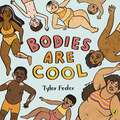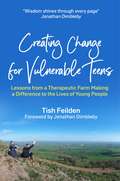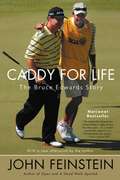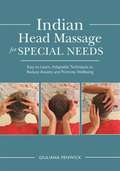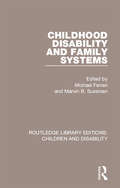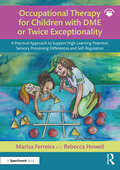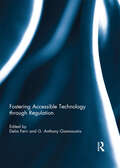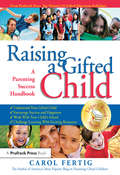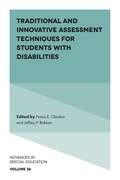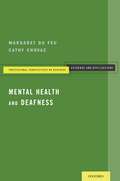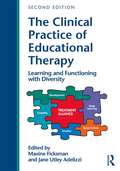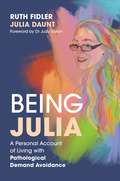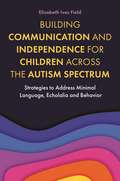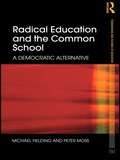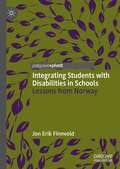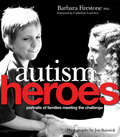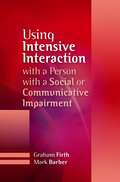- Table View
- List View
Bodies Are Cool: A picture book celebration of all kinds of bodies
by Tyler FederThis body positive picture book is a vibrant, joyful, and judgement-free celebration of every body shape and size.My body, your body, every different kind of body!All of them are good bodies! BODIES ARE COOL!This heart-warming, inclusive book, filled with detailed and friendly illustration is a celebration of every kind of body that exists in the world. Through an empowering, rhythmic text that is perfect for reading aloud, little ones can explore various skin tones, body shapes, hair types, and more, in an accessible way that instills body positivity and confidence.The picture book debut from talented author/illustrator Tyler Feder, whose inclusive artwork - full of warmth and humour - has earned her a large social media following through her brand, Roaring Softly.
Creating Change for Vulnerable Teens: Lessons from a Therapeutic Farm Making a Difference to the Lives of Young People
by Tish FeildenCreating Change for Vulnerable Teens tells the story of Tish Feilden and Jamie's Farm - a network of therapeutic farms dedicated to transforming the lives of disadvantaged children.Documenting Tish's experiences of working with truly remarkable teens who have faced huge challenges in their lives, the book describes how the farms help young people to thrive academically, socially and emotionally. She shares the approaches they have pioneered, including the critical importance of trust, of looking behind the behaviour and of really connecting with the desires and hopes of young people. If you have an interest in supporting vulnerable children or young people, this book provides a wealth of inspiration and ideas you can use, whatever the setting.
Creating Change for Vulnerable Teens: Lessons from a Therapeutic Farm Making a Difference to the Lives of Young People
by Tish FeildenCreating Change for Vulnerable Teens tells the story of Tish Feilden and Jamie's Farm - a network of therapeutic farms dedicated to transforming the lives of disadvantaged children.Documenting Tish's experiences of working with truly remarkable teens who have faced huge challenges in their lives, the book describes how the farms help young people to thrive academically, socially and emotionally. She shares the approaches they have pioneered, including the critical importance of trust, of looking behind the behaviour and of really connecting with the desires and hopes of young people. If you have an interest in supporting vulnerable children or young people, this book provides a wealth of inspiration and ideas you can use, whatever the setting.
Caddy for Life: The Bruce Edwards Story
by John FeinsteinBeyond golf's polished surface there lies a world not often seen by the average fan. The caddy sees everything - the ambition, the strategy, the rivalries, the jealousies - that occurs behind the scenes. Award-winning John Feinstein, America's favourite sportswriter, got one of golf's legendary caddies to reveal the secrets behind the most popular sport of our time. Bruce Edwards was diagnosed with Lou Gehrig's disease in January 2003, a progressive disease that attacks nerve cells in the brain and the spinal cord, but he dominated coverage of the 2003 US Open. This is a position not usually bestowed on a caddy, but Edwards was no ordinary caddy. In 1973, after forgoing college, Edwards walked on the course behind a young Tom Watson and never looked back. Watson would go on to win eight major titles with Bruce Edwards by his side. Edwards continued to do the job he had dedicated more than half his life to right up to his death in April 2004, aged 49. This is a moving, dramatic and thoughtful book about a life devoted to sports.
Indian Head Massage for Special Needs: Easy-to-Learn, Adaptable Techniques to Reduce Anxiety and Promote Wellbeing
by Giuliana FenwickThis complete manual introduces unique Indian head massage techniques to help reduce feelings of stress and anxiety, calm sensory overloads, improve sleep patterns, ease frustration and boost mental, physical and emotional wellbeing in people of all ages with special needs, including Autism Spectrum Disorders. The book provides everything you need to get started, including: - A full, step-by-step, illustrated massage routine - Essential tips on how to create the perfect environment and how to approach clients with special needs - Detailed case studies - Information on anatomy, physiology and the complementary approaches to the body - Supplementary information on essential oils Developed by Giuliana Fenwick through work with her son, and extensively trialled in schools and specialist colleges, this tailored Indian head massage is perfect for anyone looking to provide additional support to people with special needs, including parents and carers, teachers, teaching assistants and other school staff, complementary therapists and any other professionals working with people with special needs.
Indian Head Massage for Special Needs: Easy-to-Learn, Adaptable Techniques to Reduce Anxiety and Promote Wellbeing (PDF)
by Giuliana FenwickThis complete manual introduces unique Indian head massage techniques to help reduce feelings of stress and anxiety, calm sensory overloads, improve sleep patterns, ease frustration and boost mental, physical and emotional wellbeing in people of all ages with special needs, including Autism Spectrum Disorders. The book provides everything you need to get started, including: - A full, step-by-step, illustrated massage routine - Essential tips on how to create the perfect environment and how to approach clients with special needs - Detailed case studies - Information on anatomy, physiology and the complementary approaches to the body - Supplementary information on essential oils Developed by Giuliana Fenwick through work with her son, and extensively trialled in schools and specialist colleges, this tailored Indian head massage is perfect for anyone looking to provide additional support to people with special needs, including parents and carers, teachers, teaching assistants and other school staff, complementary therapists and any other professionals working with people with special needs.
Childhood Disability and Family Systems (Routledge Library Editions: Children and Disability)
by Michael Ferrari Marvin B. SussmanFirst published in 1987, this book focuses on childhood disability within the family. It examines the very nature of disability itself, as well as many of the fundamental elements of families. The book was written at a time when the meaning level of disability and its effect on family and society were rapidly changing and people with disabilities were starting to benefit from opportunities to compensate for whatever disabilities they may have had. Modern technology and an affluent society afforded advantages to support many of its disabled members. Contributors examine the contemporary context of disability, the cost of disability to families, ethical, philosophical and social issues underlying the treatment and rehabilitation of children with severe disabilities, and the role of professionals, amongst other topics. This book will be of interest to those involved in teaching, research and direct care with families who have children with disabilities. Although written in the late 80s, the work discusses subjects that are still vital today.
Childhood Disability and Family Systems (Routledge Library Editions: Children and Disability #5)
by Michael Ferrari Marvin B. SussmanFirst published in 1987, this book focuses on childhood disability within the family. It examines the very nature of disability itself, as well as many of the fundamental elements of families. The book was written at a time when the meaning level of disability and its effect on family and society were rapidly changing and people with disabilities were starting to benefit from opportunities to compensate for whatever disabilities they may have had. Modern technology and an affluent society afforded advantages to support many of its disabled members. Contributors examine the contemporary context of disability, the cost of disability to families, ethical, philosophical and social issues underlying the treatment and rehabilitation of children with severe disabilities, and the role of professionals, amongst other topics. This book will be of interest to those involved in teaching, research and direct care with families who have children with disabilities. Although written in the late 80s, the work discusses subjects that are still vital today.
Occupational Therapy for Children with DME or Twice Exceptionality: A Practical Approach to Support High Learning Potential, Sensory Processing Differences and Self-Regulation
by Mariza Ferreira Rebecca HowellChildren with high learning potential or giftedness have remarkable potential. Despite this, these children can struggle to participate in everyday life because of a range of needs that are sometimes misunderstood, overlooked or not adequately addressed, leading to underachievement and, in turn, low self-esteem. Needs that, in many cases, paediatric occupational therapists are best suited to address. The practical resource offered in the book, the DME-C approach, is a tried-and-tested approach to help children who have challenges relating to their high learning potential, as well as sensory processing differences, unhelpful thought patterns and self-regulation. It draws on the heart of occupational therapy that considers the whole profile of the child, actively caters to the unique profiles of children with dual or multiple exceptionality (DME) or twice exceptionality (2e), and guides therapists towards therapy provision that is strengths-based and achieves favourable outcomes. This book: ● Includes a clear and comprehensive introduction to high learning potential and DME or twice exceptionality (2e), along with guidance to help identify children with these profiles. ● Covers questions and concerns occupational therapists may have when working with children with DME or 2e. ● Considers the similarities and differences between high learning potential/DME/2e and neurodivergent conditions such as developmental coordination disorder, autism and ADHD, with a focus on sensory processing differences. ● Explains, in easy-to-understand language, the full DME-C therapy approach, with a range of example activities to use in therapy to achieve its principles, and a suggested therapy progression plan. ● Is packed full of real-life case studies to translate theory into practice. ● Empowers therapists and educational professionals further by drawing attention to how they can better relate to children with DME/2e in therapy regardless of the children’s specific needs. Full of examples and with the voices of parents and children at its heart, this resource is essential reading for occupational therapists, SENCOs, education psychologists and other relevant professionals, who want to improve the lives and wellbeing of children with DME or twice exceptionality and help them reach their full potential.
Occupational Therapy for Children with DME or Twice Exceptionality: A Practical Approach to Support High Learning Potential, Sensory Processing Differences and Self-Regulation
by Mariza Ferreira Rebecca HowellChildren with high learning potential or giftedness have remarkable potential. Despite this, these children can struggle to participate in everyday life because of a range of needs that are sometimes misunderstood, overlooked or not adequately addressed, leading to underachievement and, in turn, low self-esteem. Needs that, in many cases, paediatric occupational therapists are best suited to address. The practical resource offered in the book, the DME-C approach, is a tried-and-tested approach to help children who have challenges relating to their high learning potential, as well as sensory processing differences, unhelpful thought patterns and self-regulation. It draws on the heart of occupational therapy that considers the whole profile of the child, actively caters to the unique profiles of children with dual or multiple exceptionality (DME) or twice exceptionality (2e), and guides therapists towards therapy provision that is strengths-based and achieves favourable outcomes. This book: ● Includes a clear and comprehensive introduction to high learning potential and DME or twice exceptionality (2e), along with guidance to help identify children with these profiles. ● Covers questions and concerns occupational therapists may have when working with children with DME or 2e. ● Considers the similarities and differences between high learning potential/DME/2e and neurodivergent conditions such as developmental coordination disorder, autism and ADHD, with a focus on sensory processing differences. ● Explains, in easy-to-understand language, the full DME-C therapy approach, with a range of example activities to use in therapy to achieve its principles, and a suggested therapy progression plan. ● Is packed full of real-life case studies to translate theory into practice. ● Empowers therapists and educational professionals further by drawing attention to how they can better relate to children with DME/2e in therapy regardless of the children’s specific needs. Full of examples and with the voices of parents and children at its heart, this resource is essential reading for occupational therapists, SENCOs, education psychologists and other relevant professionals, who want to improve the lives and wellbeing of children with DME or twice exceptionality and help them reach their full potential.
Fostering Accessible Technology through Regulation
by Delia Ferri G. Anthony GiannoumisTechnology has attracted an increasing level of attention within studies of disability and disability rights. Many researchers and advocates have maintained skepticism towards technology out of the fear that technology becomes another way to ‘fix’ impairments. These skeptical views, however, contrast with a more positive approach towards the role that technology can play in eliminating barriers to social participation. Legal scholarship has started to focus on accessibility and accessible technology and in conjunction with the recently adopted United Nations Convention on the Rights of Persons with Disabilities has put a great emphasis on accessibility, highlighting the role that accessible technology plays in the promotion and protection of the rights of people with disabilities. Against this background, this book gathers together different contributions that focus on enhancing the production, marketing and use of accessible technology. Building upon previous academic studies and in light of the UNCRPD, accessible technology is considered a tool to increase autonomy and participation. Overall, this book attempts to show, through a multifaceted and inter-disciplinary analysis, that different regulatory approaches might enhance accessible technology and its availability. This title was previously published as a special issue of the International Review of Law, Computers & Technology.
Raising a Gifted Child: A Parenting Success Handbook
by Carol FertigFrom the author of the nation's most popular blog on parenting gifted children comes the definitive how-to manual for parents, Raising a Gifted Child: A Parenting Success Handbook, a gifted education Legacy Award winner. Raising gifted children isn't easy, but when armed with the practical knowledge and tools in this exciting book, parents can navigate the maze of raising bright kids, leading to success in school and beyond. This book offers a large menu of strategies, resources, organizations, tips, and suggestions for parents to find optimal learning opportunities for their kids, covering the gamut of talent areas, including academics, the arts, technology, creativity, music, and thinking skills. The focus of this definitive resource is on empowering parents by giving them the tools needed to ensure that their gifted kids are happy and successful both in and out of school.Additional topics covered include volunteering at their child's school; different school options and specialty programs; tips for handling special circumstances; specific suggestions for each core content area; and strategies for finding the best resources for parents on the Web. This easy-to-read book is sure to be a favorite of parents of smart kids for years to come!Educational Resource
Raising a Gifted Child: A Parenting Success Handbook
by Carol FertigFrom the author of the nation's most popular blog on parenting gifted children comes the definitive how-to manual for parents, Raising a Gifted Child: A Parenting Success Handbook, a gifted education Legacy Award winner. Raising gifted children isn't easy, but when armed with the practical knowledge and tools in this exciting book, parents can navigate the maze of raising bright kids, leading to success in school and beyond. This book offers a large menu of strategies, resources, organizations, tips, and suggestions for parents to find optimal learning opportunities for their kids, covering the gamut of talent areas, including academics, the arts, technology, creativity, music, and thinking skills. The focus of this definitive resource is on empowering parents by giving them the tools needed to ensure that their gifted kids are happy and successful both in and out of school.Additional topics covered include volunteering at their child's school; different school options and specialty programs; tips for handling special circumstances; specific suggestions for each core content area; and strategies for finding the best resources for parents on the Web. This easy-to-read book is sure to be a favorite of parents of smart kids for years to come!Educational Resource
Traditional and Innovative Assessment Techniques for Students with Disabilities (Advances in Special Education #36)
by Festus E. Obiakor, Jeffrey P. BakkenIn order to properly understand and compare traditional and innovative assessment techniques for students with disabilities, we must be able to access examples of how they work in a logical and thoughtful sequence. This finely curated collection of thirteen chapters presents ideas and research on different disability topics from key leaders in the field of the assessment of children with disabilities. Written by well-known and respected researchers, scholars, and educators who are actively involved in teaching undergraduate and graduate special education courses on the assessment of students with disabilities, this volume opens with a thorough introduction on the current situation. The topics covered by the remaining chapters include students with learning and intellectual disabilities, emotional and behavioral disorders, sensory impairments, extensive support needs, traumatic brain injuries, and those who are culturally and linguistically diverse, autistic, and those who have physical disabilities. The concluding chapter muses on what the future holds for traditional and innovative assessment techniques for students with disabilities. This volume is an excellent resource for special education researchers, scholars, practitioners, and professionals who teach and serve young learners with disabilities.
The Clinical Practice of Educational Therapy: Learning and Functioning with Diversity
by Maxine Ficksman Jane Utley AdelizziDespite the wide array of services offered to students with learning disabilities, attention-deficit disorder, and a variety of comorbid conditions, large numbers of students are caught in the struggle of surviving school. Unfortunate school experiences may impact their sense of self and the degree of tenacity with which they pursue further training or challenging opportunities in the workplace. These are the people for whom educational therapy provides relief, enlightenment, and the coveted prize of success. The second edition of The Clinical Practice of Educational Therapy, the first textbook in its field, provides a comprehensive perspective of this interdisciplinary profession and practice, reaching out to a more global audience. The book describes the scope and practice of educational therapy from its European roots to its growing presence in the United States, providing readers with case studies and research that illustrate the work of educational therapists across the lifespan in diverse settings. Interdisciplinary Perspective — Other books focus on either educational or therapeutic interventions but rarely discuss the blend and synergy of disciplines (e.g., special education, neuropsychology, assessment, and social work) that are the hallmark of this unique profession. Illustrative Cases — The text draws heavily on case studies as a means of understanding the practice of educational therapy, especially the dynamic relationship that exists between therapist and client. Numerous charts and tables provide visuals for educational therapists as well as allied professionals, parents, and those with learning challenges. Expertise — The editors are both highly visible educational therapists. Chapter authors are either experienced educational therapists or allied professionals who have made scholarly contributions to the profession, such as Trisha Waters, Roslyn Arnold, and George McCloskey. In addition to benefiting educational therapists and students, this book is appropriate for professionals who work in related fields such as special education, regular education, school and educational psychology, neuropsychology, school counseling, psychology, speech and language pathology, art therapy, occupational therapy, and social work, as well as in medicine and psychiatry. NEW TO THE SECOND EDITION The second edition of The Clinical Practice of Educational Therapy: Learning & Functioning with Diversity has revised and updated the chapters from the first edition, and added three new chapters which further define and broaden this field by exploring diverse perspectives: Chapter 10, "Cultivating Character Development: Educational Therapy’s Impact on Individuals, Families, Schools, Educational Policy, and Society" by Maxine Ficksman Chapter 12, "Women and Girls Who Are Disenfranchised: A Global and Interdisciplinary Approach to Educational Therapy" by Jane Utley Adelizzi Chapter 17, "Examining the Efficacy of Graduate Programs in Educational Therapy at California State University, Northridge (CSUN): Educational Therapy Intern, Graduate and Parent Perspectives" by Marcy Dann, Nancy Burstein, Tamarah Ashton, and Sue Sears. These additional chapters, supported by brain-based research, characterize the shifts and changes experienced in a range of settings. Through the treatment alliance, educational therapists address students’ and clients’ ability to experience a more comprehensive model of learning, dependent upon the psychological, social, emotional, cultural and academic environments. The three new chapters range in focus from formal research and graduate training in the field of educational therapy to students throughout the lifespan whose social and educational experiences require a careful eye to not only the academic task at hand but also to the ways in which they cope and adapt to a range of environments and challenges. Lastly, educational therapy’s empathic foundation in practice is exemplified when we consider the global experience of students who strive to learn in situations and settings that threaten their survival a
The Clinical Practice of Educational Therapy: Learning and Functioning with Diversity
by Maxine Ficksman Jane Utley AdelizziDespite the wide array of services offered to students with learning disabilities, attention-deficit disorder, and a variety of comorbid conditions, large numbers of students are caught in the struggle of surviving school. Unfortunate school experiences may impact their sense of self and the degree of tenacity with which they pursue further training or challenging opportunities in the workplace. These are the people for whom educational therapy provides relief, enlightenment, and the coveted prize of success. The second edition of The Clinical Practice of Educational Therapy, the first textbook in its field, provides a comprehensive perspective of this interdisciplinary profession and practice, reaching out to a more global audience. The book describes the scope and practice of educational therapy from its European roots to its growing presence in the United States, providing readers with case studies and research that illustrate the work of educational therapists across the lifespan in diverse settings. Interdisciplinary Perspective — Other books focus on either educational or therapeutic interventions but rarely discuss the blend and synergy of disciplines (e.g., special education, neuropsychology, assessment, and social work) that are the hallmark of this unique profession. Illustrative Cases — The text draws heavily on case studies as a means of understanding the practice of educational therapy, especially the dynamic relationship that exists between therapist and client. Numerous charts and tables provide visuals for educational therapists as well as allied professionals, parents, and those with learning challenges. Expertise — The editors are both highly visible educational therapists. Chapter authors are either experienced educational therapists or allied professionals who have made scholarly contributions to the profession, such as Trisha Waters, Roslyn Arnold, and George McCloskey. In addition to benefiting educational therapists and students, this book is appropriate for professionals who work in related fields such as special education, regular education, school and educational psychology, neuropsychology, school counseling, psychology, speech and language pathology, art therapy, occupational therapy, and social work, as well as in medicine and psychiatry. NEW TO THE SECOND EDITION The second edition of The Clinical Practice of Educational Therapy: Learning & Functioning with Diversity has revised and updated the chapters from the first edition, and added three new chapters which further define and broaden this field by exploring diverse perspectives: Chapter 10, "Cultivating Character Development: Educational Therapy’s Impact on Individuals, Families, Schools, Educational Policy, and Society" by Maxine Ficksman Chapter 12, "Women and Girls Who Are Disenfranchised: A Global and Interdisciplinary Approach to Educational Therapy" by Jane Utley Adelizzi Chapter 17, "Examining the Efficacy of Graduate Programs in Educational Therapy at California State University, Northridge (CSUN): Educational Therapy Intern, Graduate and Parent Perspectives" by Marcy Dann, Nancy Burstein, Tamarah Ashton, and Sue Sears. These additional chapters, supported by brain-based research, characterize the shifts and changes experienced in a range of settings. Through the treatment alliance, educational therapists address students’ and clients’ ability to experience a more comprehensive model of learning, dependent upon the psychological, social, emotional, cultural and academic environments. The three new chapters range in focus from formal research and graduate training in the field of educational therapy to students throughout the lifespan whose social and educational experiences require a careful eye to not only the academic task at hand but also to the ways in which they cope and adapt to a range of environments and challenges. Lastly, educational therapy’s empathic foundation in practice is exemplified when we consider the global experience of students who strive to learn in situations and settings that threaten their survival a
Being Julia - A Personal Account of Living with Pathological Demand Avoidance
by Ruth Fidler Julia DauntDiagnosed with Pathological Demand Avoidance (PDA) at aged 12 and writing this memoir at age 37, Julia Daunt depicts the ins and out of PDA and its symptoms, while maintaining a positive outlook on what is possible to achieve. Co-written with professional specialist Ruth Fidler, it covers how PDA impacts Julia's life, including meltdowns, sensory issues and communication in relationships.Including examples of school reports and handwritten letters, a chapter written from Julia's partner's perspective and even an example of Julia's favourite recipe, this warm and personal look at living and thriving with PDA is informative and inspiring.
Building Communication and Independence for Children Across the Autism Spectrum: Strategies to Address Minimal Language, Echolalia and Behavior
by Elizabeth FieldExpert author Elizabeth Ives Field combines over four decades of working in the autism field to provide functional, in-depth teaching strategies for children on the spectrum who struggle with communication. Incorporating descriptions of composite children at different developmental stages, this book sets out individual goals and therapy approaches for children who may have no speech, moderately functional speech or echolalia, as well as for highly verbal individuals who may not always use appropriate language. Covering a wide range of interventions that address communication and the related areas of independence and social behavior, the purpose of each goal is to make progress toward the child's maximum potential. This book sets out skills that are developmentally appropriate and that will be immediately useful to help children express themselves more effectively and build relationships with others.
Building Communication and Independence for Children Across the Autism Spectrum: Strategies to Address Minimal Language, Echolalia and Behavior
by Elizabeth FieldExpert author Elizabeth Ives Field combines over four decades of working in the autism field to provide functional, in-depth teaching strategies for children on the spectrum who struggle with communication. Incorporating descriptions of composite children at different developmental stages, this book sets out individual goals and therapy approaches for children who may have no speech, moderately functional speech or echolalia, as well as for highly verbal individuals who may not always use appropriate language. Covering a wide range of interventions that address communication and the related areas of independence and social behavior, the purpose of each goal is to make progress toward the child's maximum potential. This book sets out skills that are developmentally appropriate and that will be immediately useful to help children express themselves more effectively and build relationships with others.
Radical Education and the Common School: A Democratic Alternative (Foundations and Futures of Education)
by Michael Fielding Peter MossWhat is education, what is it for and what are its fundamental values? How do we understand knowledge and learning? What is our image of the child and the school? How does the ever more pressing need to develop a more just, creative and sustainable democratic society affect our responses to these questions? Addressing these fundamental issues, Fielding and Moss contest the current mainstream dominated by markets and competition, instrumentality and standardisation, managerialism and technical practice. They argue instead for a radical education with democracy as a fundamental value, care as a central ethic, a person-centred education that is education in the broadest sense, and an image of a child rich in potential. Radical education, they say, should be practiced in the ‘common school’, a school for all children in its local catchment area, age-integrated, human scale, focused on depth of learning and based on team working. A school understood as a public space for all citizens, a collective workshop of many purposes and possibilities, and a person-centred learning community, working closely with other schools and with local authorities. The book concludes by examining how we might bring such transformation about. Written by two of the leading experts in the fields of early childhood and secondary education, the book covers a wide vista of education for children and young people. Vivid examples from different stages of education are used to explore the full meaning of radical democratic education and the common school and how they can work in practice. It connects rich thinking and experiences from the past and present to offer direction and hope for the future. It will be of interest and inspiration to all who care about education - teachers and students, academics and policy makers, parents and politicians.
Radical Education and the Common School: A Democratic Alternative (Foundations and Futures of Education)
by Michael Fielding Peter MossWhat is education, what is it for and what are its fundamental values? How do we understand knowledge and learning? What is our image of the child and the school? How does the ever more pressing need to develop a more just, creative and sustainable democratic society affect our responses to these questions? Addressing these fundamental issues, Fielding and Moss contest the current mainstream dominated by markets and competition, instrumentality and standardisation, managerialism and technical practice. They argue instead for a radical education with democracy as a fundamental value, care as a central ethic, a person-centred education that is education in the broadest sense, and an image of a child rich in potential. Radical education, they say, should be practiced in the ‘common school’, a school for all children in its local catchment area, age-integrated, human scale, focused on depth of learning and based on team working. A school understood as a public space for all citizens, a collective workshop of many purposes and possibilities, and a person-centred learning community, working closely with other schools and with local authorities. The book concludes by examining how we might bring such transformation about. Written by two of the leading experts in the fields of early childhood and secondary education, the book covers a wide vista of education for children and young people. Vivid examples from different stages of education are used to explore the full meaning of radical democratic education and the common school and how they can work in practice. It connects rich thinking and experiences from the past and present to offer direction and hope for the future. It will be of interest and inspiration to all who care about education - teachers and students, academics and policy makers, parents and politicians.
Integrating Students with Disabilities in Schools: Lessons from Norway
by Jon Erik FinnvoldThis book explores the ability of the Norwegian school system to support the achievement of formal competencies among children with physical disabilities, as well as its role in the informal dimensions of social participation and networking. Schools contribute to social inclusion in several ways: they are arenas for building official competencies, ensuring future access and success in the labour market. They are also sites for meeting other children, and developing friendships – friendships are not only important for strengthening cognitive development, but are vital to both good mental health and the building of various forms of social capital. By examining schools and the ways in which inclusion is incorporated early, this book aims to bridge the opportunity and employment gap that people with physical disabilities are more likely to face later in life.
Autism Heroes: Portraits of Families Meeting the Challenge (PDF)
by Barbara Firestone Ted ColeIntimate, bold, and inspiring, Autism Heroes provides a compelling and sensitive account of the experiences of 38 families from different walks of life confronting the challenges of autism with courage, tenacity and love. With empathy and expertise gained from her three decades of leadership of The Help Group and commitment to children with special needs, Dr. Barbara Firestone engages the families in candid, powerful and deeply affecting conversations about their lives. Each family narrative is set against the backdrop of her insightful essays about dignity, hope, opportunity and love, which are fundamentally important to all families living with autism. The families offer their experiences openly and honestly, sharing their challenges, triumphs, and hopes. Their candor helps demystify and destigmatize autism and embraces other parents just beginning or already on the journey. Their reflections chart the course through the many stages of coping with autism and seeking solutions for their children, and they offer a lifeline of support, insight and encouragement and hope. Fully illustrated with stunning photographs by Joe Buissink, Autism Heroes is an invaluable resource for families as well as educators, clinicians, researchers and policy makers.
Using Intensive Interaction with a Person with a Social or Communicative Impairment
by Graham Firth Mark BarberIntensive Interaction is a highly effective approach for communicating and developing social interaction and engagement with difficult-to-reach individuals. This easy-to-use guide steers readers through the practical application of the approach, showing how positive results can best be achieved. The authors explain clearly how to prepare for, carry out and reflect on the use of Intensive Interaction with a client or family member. A multitude of key questions are addressed, including finding the right setting, evaluating progress and disengaging effectively at the end of a session. In the final section they consider some of the wider implications of the approach, such as developing confidence as a practitioner and incorporating Intensive Interaction into long-term care or educational planning. This practical and accessible book is a useful resource for speech and language therapists, occupational therapists, special school or further education teachers, social care professionals and anyone else caring for or working with people with social or communicative impairments. It will also be useful to practitioners already using the approach.
